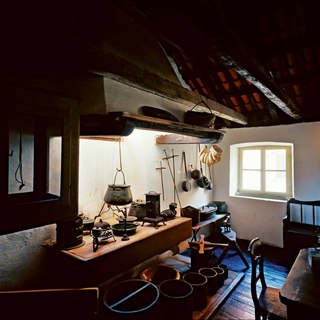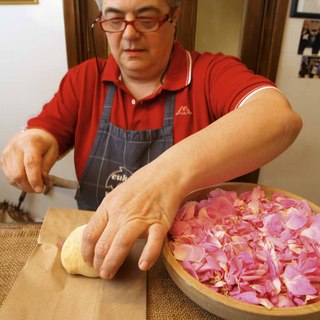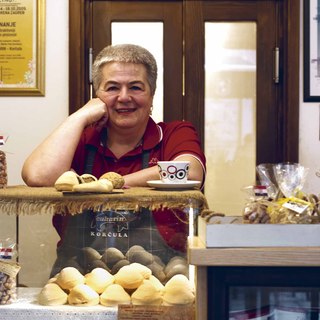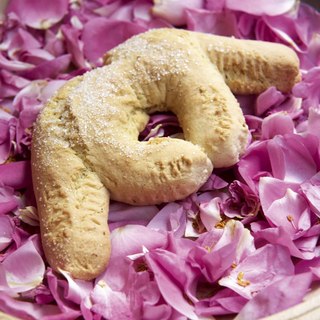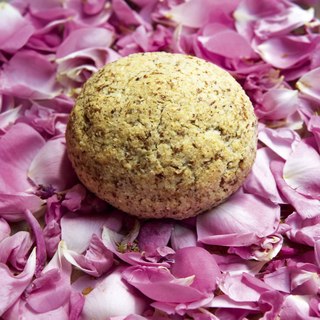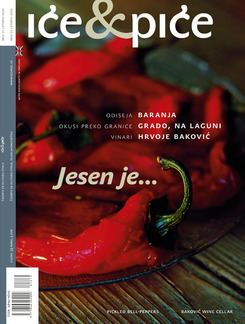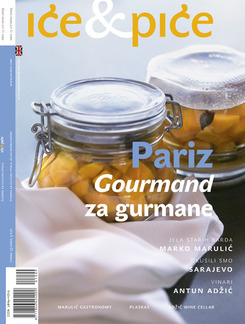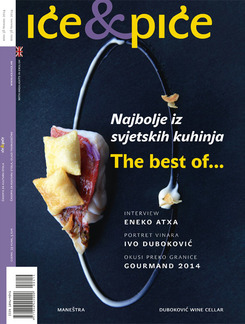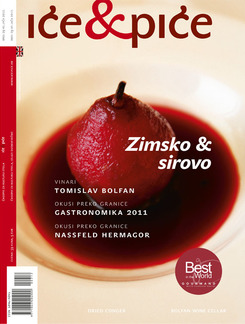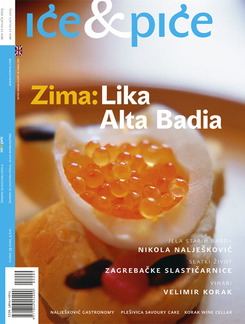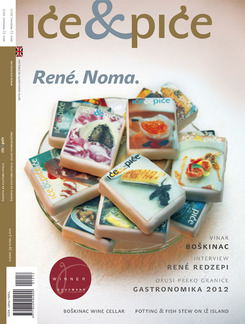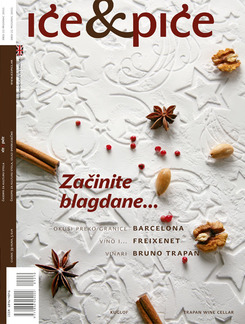How strange today is the old French saying like an apothecary with no sugar or a scene from black and white films in which chemists are selling candies and ice-cream. But a couple of hundred years ago chemists held the sugar trade, of that expensive and highly desired comestible that was considered a medicine and commanded extremely high prices. But the links of druggist and kitchen do not begin and end with sugar. The similarity is not only in the pestles and mortars, the porcelain and glass phials, but also in the precise measuring, in the talent of apothecary and cook, who cure us and gladden us. In kitchens, as orderly as apothecaries’ shops, for centuries alchemy has been going on, so that not even molecular cookery is precisely a novelty.
On the Dalmatian islands, and it is true on occasions in the far north of Europe, the old habit of letting some of the ingredients for cakes wander off into the chemist’s has still not died out. Everything else is at hand – the local lemons and bitter oranges, almonds, carob and a lot of sun that ruthlessly pulls out the most pungent aromas. Green and fertile Korčula is revealed as rich and refined in its cakes. The sophisticated little old fashioned dry Korčula cookies preserve the essence of all the rich aromas of fruits and plants of the Mediterranean. The discreet acerbity of the clime and the scent of citruses are the basis of all Dalmatian desserts. The coast perhaps cannot brag of profligate gateaux and crèmes, but is unrivalled in its dry biscuits. The Istrian cukerančić steeped in sugar and brandy, the Vis and the Hvar cvit aromatised with anise or the paprenjak are just a small part of a forgotten multitude of recipes that occasionally shine out like put-away family silver. The tin boxes from the sideboard that quietly smell of mištral and roses, long keep cakes whose key ingredients are kept in the nearby (if you are on an island) chemists.
(NH4)2CO3
Not a one of these lovely island biscuits and cakes such as the cukarin, cvit or paprenjak would be the same without a bit of druggist’s skill and ammoniac. In fact, ammonia carbonate, unjustly neglected forebear of baking powder. Many once ordinary ingredients of the kitchen sound at the very least outlandish today, and once upon a time to make pastry light the occasional horror has been used. Dough could have rum or cognac added to it, or as wicked Parisian tongues sometimes wagged, pigeon droppings, which on heating let out ammoniacal gas. We often have no way of testing historical circumstances, but it is possible to imagine how much hard work and economy was needed to find out that from deer horn it was possible to make raising powder and a preparation for clarifying drink. Kitchen tricks are perhaps one of the most interesting parts of cooking, and the boiling and distillation of hart’s horns sound a little bit like witches’ brews or the laboratory of the apothecary. Baker’s ammoniac or hartshorn, Hirschhornsalz in German, releases a gas on baking that lightens the pastry or dough and then vanishes, though giving off a vile smell during the baking process. When it has completely evaporated (and it can be used only for baking thin dough), it leaves no kind of smell or aroma. Only the lightest possible dough. The masters of old fashioned cookies claim that ammoniac absolutely must not be replaced by baking powder of soda bicarbonate. Out of the question. Nothing is better than ammoniac, or it’s just not the thing. At the beginning of the twentieth century, cookery books were still mentioning ammoniac for biscuits. We can find it in the Kumičić cook book, as well as that of hand written recipe books, like that of Nona Carmen. It’s still used occasionally in Germany, Austria and Scandinavia for old-fashioned recipes for crackers or biscuits for keeping. Chemical explanation has long since been of no great importance, since the tried-and-tested recipes have been confirmed as unquestioned authorities and are passed down and survive, even if they have skipped the odd generation. The experienced say that baking powder raises dough upwards, while ammoniac expands it, making it porous. Ideal for subsequent flavouring with sugar or scented liqueurs, such as rožolin, made of rose petals, or mištral, anise liqueur, also to be found in the chemist’s.
Cukarin
Many recipes are today coming back from the verge of oblivion, and nostalgia is our most frequent weapon against the uniform and boring global food that nourishes us at high speed. The wisdom of old kitchen notebooks did not get outmoded with use. New recipes are created, come in and go out of fashion, while all of us long for the honest food of childhood. The embodiment of love and care. Such, I suppose, was the idea of Smiljana Matijaca had when she started her Korčula business. Probably these wonderful little cookies that draw us from the very door of Smiljana’s shop would have remained but a rare treat on Korčula tables. Recipes are exchanged, perhaps faster than ever, although recipes always moved at the speed of gossip. TV and papers and Internet are bursting with delicious and irresistible dishes. Forums are crammed with commentaries and advice for many traditional treats, and all dishes are easily available. Words, however written, today cost almost nothing. Internet cookery is ruled by the familiar anonymity that accompanies kitchen history. We don’t put up monuments to the creators of dishes, nor do we name streets after them, although mankind owes more to a new dish invented than it does to the discovery of a new star.
The past of this Korčula cookie evades me in the multitude of similar Mediterranean recipes. The klašun is apparently the simplest cake of short pastry stuffed with nuts, like sweet carnival rafioli. The stuffing can vary, and the little cushions of pastry conceal almonds, walnuts, cheese, dried fruit... We can only collect numerous recipes and slowly try them out and mark down the differences. Although similar, the preparation and the occasion for which they are made, differ from place to place. On Korčula they are made at a time when it was necessary to show abundance and when they had to keep. There was always an impulse to forestall time by putting foods away, and the simple everyday life seldom offered anything sweet. The klašun was once only made for special occasions, usually for all rites of passages, from baptism to weddings. Probably the richer households had reserves to offer unexpected guests. The unexpected guest had to be offered something, and that something would be kept in the tins and on plates of biscuits that stood on the sideboards. The klašun is a cookie that keeps wonderfully, if it is allowed to. Only after two or three days does it become perfect. A crumbly, soft, sweet nutty morsel that can last days. A bit further, on Pelješac Peninsula, the klašun is a hot and sweet morsel typical of the Mediterranean carnival. Like the many sweet versions of ravioli that are prepared on both sides of the Adriatic, fried cakes are always put on the table for serious gorging before a fast 40 days long.
Love for baking cakes and old recipes impelled Smiljana in 1994 to open the door of the sweetest shop on Korčula. Cukarin is not a fashionable cafe, a dull or tarty pastry-shop, but a simple little shop in which on the whole old-fashioned Korcular sweets are bought. Hard to choose, until you find your favourite. Perhaps the short cukarin with a slight citrus flavour, usually served with prošek, the delicious harubica, of carob and orange marmalade, delicate amarettos of almonds that are prepared elsewhere only on Sardinia, the one-time nuptial klašun flavoured with rose brandy, the recipe for which Smiljana reconstructed from a number of recipes, some of which are more than a hundred years old or the irresistible favourite sugared almond (broštulan). Almonds are prepared in two ways on Korčula – in caramel and white. These last are specialities of Korčula, and are prepared nowhere else. Each one of these cookies is special, but all tell a sincere tale of love, time and island.
